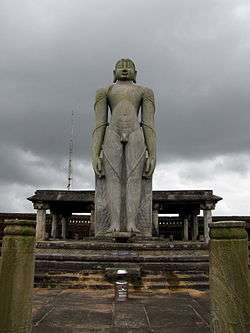Santara dynasty
Santara or Bhairarasa[Note 1] is the name of a medieval ruling dynasty of Karnataka, India.[1] The area covered by their kingdom included territories in the Malenadu region as well as the coastal districts of Karnataka.[2] Their kingdom had two capitals. Karkala in the coastal plains and Kalasa in the Western ghats. Hence the territory they ruled was also known as the Kalasa-Karkala kingdom. The Santaras were Jains and had matrimonial relations with the Saivite Alupa royal family.[2] The Santaras became the feudatories of the Vijayanagara Empire after its rise. During this period the Santara ruler Veera Pandya Bhairarasa erected the monolith of Bahubali in Karkala.[2] The dynasty passed into oblivion after invasions by the Nayakas of Keladi and later by Hyder Ali

History
Jinadatta Raya or Jindutt Rai, a Jain prince from Mathura in Northern India was the supposed founder of the dynasty.[3] He is said to have migrated to the town of Humcha with an idol of the Jain deity Padmavati laying the foundation of the kingdom in Humcha.
Edgar Thurston mentions that the Bhairarasas or Santaras were among the powerful Bunt [4] chiefs who seem to have exercised control over a greater part of the Tuluva country before the rise of the Vijayanagara Empire. The dynasty founded by Jinadatta appears to have split into two branches by the 12 century C.E. One branch being stationed in Kalasa and another in Hosagunda of Shimoga district. Gradually these branches shifted their capitals to Keravashe and Karkala both in the old South Canara district.
The Santaras built a number of Jain monuments and were responsible for the spread of Jainism in the Tulu Nadu and Malenadu region of Karnataka.[1]
Notes
- Alternate forms of the dynasty's name include Santha, Santa, Santhara. They kings of the dynasty also attached titles like Pandya and Odeya to their names.
Reference
- Chavan, Shakuntala Prakash (2005). Jainism in Southern Karnataka Up to AD 1565. D.K. Printworld. pp. 181–183. ISBN 9788124603154. Retrieved 24 February 2018.
- Prabhu, Ganesh. "Karkala gears up for `Mahamastakabhisheka'". www.thehindu.com. The Hindu. Retrieved 24 February 2018.
- Jaganathan, Rijutha. "Humcha's Jain heritage". www.deccanherald.com. Deccan Herald. Retrieved 24 February 2018.
- Thurston, Edgar; K. Rangachari (1909). Castes and Tribes of Southern India Volume 1.Pg. 152 Madras: Government Press